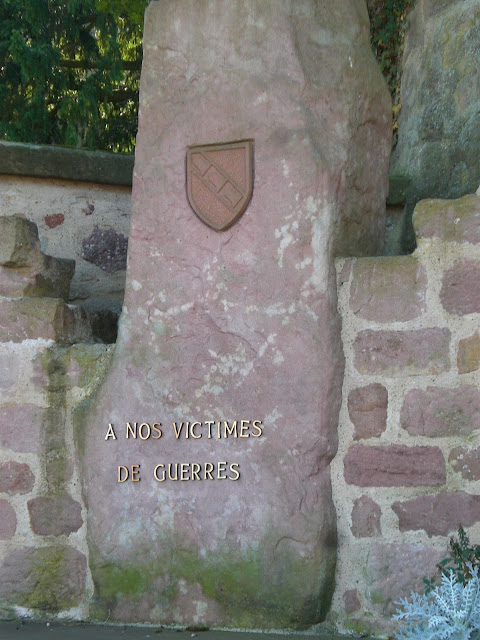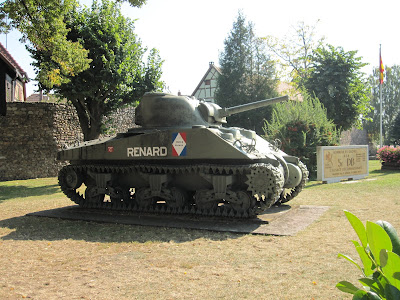After a short rest at Lalaye, orders came down for the 409th infantry to continue east to Sélestat - the end point of what we 21st century 409 groupies called the First Push. This push started with the Meurthe River crossing, the mopping up of the enemy forces in St. Dié, the long hard dangerous winter slog over the Vosges Mountains, and the battles for every village where the German army fiercely clung to its western front.
Now it was time to push the enemy further east, back over the Rhine River.
First into the fray was the 3rd Battalion. They were to secure anti-tank positions above the main road from Villé to Ramstein by taking the villages on the flank of Frankenbourg Mountain.
This detail (right) from the Route des Vins map shows the Frankenbourg Mountain and the main roads that follow the waterways downhill through the valleys on each side of the mountain.
The villages of Dieffenbach-au-Val, Neuve Église, Hirtzelbach, and Breitenau were above the Villé-to-Ramstein road up on small country lanes.
At 1600 hours, "L" Company led the 3rd Battalion to Dieffenbach (letter D on map below) where they began firing on enemy positions. "The attack proper began at 1800 hours and by 1830 part of the town had fallen." The troops held their positions for the night, wth orders to take the rest of the town in the morning.
November 28, 1944

At 0600 the next morning, "I" Company, 3rd Battalion attacked the town of Neuve Église (letter A) where they took 51 prisoners, including 2 officers. Then "I" company moved on to take the town of Hirtzelbach (letter C) at 1600 hours.
November 29, 1944
Reinforcements came to "L" company when "I" company joined them in the attack on remaining German positions in Dieffenbach. The town was in American hands by 1400 hours. "I" Company moved on to Breitenau (letter B on map above) which was occupied by 2000 hours.
November 30, 1944
In the meantime, the 1st Battalion had been marching east along a northern route to Dambach-la-Ville which they attacked on November 30. (Green line below)
"After a day of bitter fighting, the town fell with the exception of a few isolated pockets. By 2400 all of the town had been cleared and roadblocks and outposts established. The road to Sélestat was being cleared!"
"The month of November came to an end for the 409th Infantry. The men knew what combat was now. They had won victories. For them they had paid with the lives of 36 of their buddies killed in action, 56 slightly wounded in action, 20 seriously wounded in action, 23 injured in action, 17 missing in action and 4 dead of wounds.
But there were "even worse days in the way of casualties and fighting awaiting them in December."
December 1, 1944
The campaign to capture Sélestat continues. With the 3rd Battalion held in reserve in St. Maurice, the 1st and 2nd battalions moved on toward the city. They had support on their left flank from the 410th, 411th Infantries and the 14th Armored Division.
"The little town of Scherwiller was occupied early in the afternoon and the force moved on. Mist in the zone of operations was heavy, obscuring targets and making the artillery missions difficult, if not impossible. The rain of the Vosges Mountains was left behind; the snow and cold of the open plains lay ahead."
 |
| Battalion routes to Sélestat |
December 2, 1944
Before midnight, the 1st Battalion had advanced as far as the railroad tracks in the northern part of Sélestat. In the very early hours, "B" company launched an attack across the river and captured the first six houses of the town. "Little did they realize at the time the catastophe that was about to overtake their temporary success."
"At 0330 hours, three Jerry tanks rumbled down the road and without further warning, opened up at point-blank range on the buildings .... pouring round after round into them." Behind the tanks was a large force of enemy infantry, who quickly forced the Americans to surrender. The result of this action was 98 men captured, 1 killed, and 2 injured.
Several American troops holed up in another house ran out the back door of their billet, but the Germans were so close they managed to capture the last one fleeing. The others ran into an adjoining building where they overpowered three Germans. A small group of soldiers hiding in a fourth house remained quiet, hoping they would escape detection until reinforcements could arrive. This proved to be true, as another patrol joined them at 1000 hours.
In yet another house, a group of soldiers was attacked by two tanks and enemy infantry. They attempted to surrender, but that was disregarded and the enemy renewed fire. Eight of them escaped out the back of the building through a hole made by one of the tank guns. As they ran away, they saw the Germans capture the rest of the men attempting to escape. The eight managed to make it back to Dambach-la-Ville.
Meanwhile the Germans put a captured American medic and an aid man in charge of tending the injured, while the prisoners and walking wounded were marched away. At daylight, the medic spotted American tanks across the stream and snuck away to get help. Then he returned and remained with the casualties until Sunday morning Dec. 3. Only 15 of the men of the 1st Battalion who had crossed the river, managed to escape.
 |
| Map from the The 409th Infantry Journal |
The 2nd Battalion, coming from the west, arrived at the outskirts of Sélestat. Marching with them, they had the support of a Tank Battalion and a Tank Destroyer Battalion. They too encountered "stiff resistance in the form of armor, artillery, mortar, automatic weapons and roadblocks that were heavily protected by high concentrations of enemy fire power and troops."
December 3, 1944
" The fight for Sélestat continued with the infantry forced to battle alone...because the armor could not cross the stream. Tank destroyers entered the town in the afternoon and the 409th Infantry was assigned the task of protecting them from antitank fire."
The battle was still raging when at 1715 hours "Task Force Sélestat was created for the specific purpose of capturing Sélestat." There were companies of infantry, a medical battalion, an engineer battalion, a tank battalion, a tank destroyer battalion, and a chemical battalion. These were organized into assault teams which proved to be very effective.
"For four years the city had been a German supply and evacuation depot and Jerry didn't want to give the city up without a fight. Sélestat was a "defending machine gunner's or mortarman's dream" because it was situated like a "pancake on a griddle". "Around the town, as an outer defensive ring, the Krauts had deeply dug in machine-gun emplacements. It took a lot of pounding to get them out. The town divulged ponderous six-foot-thick roadblocks, heavily mined and effectively covered by sniper fire."
"But all of this was gone now, taken away from the Germans by the 409th and its accompanying forces, 'veterans' of less than a month in warfare." The city was taken by the end of the day.
 |
| Modern road sign announcing the city boundary. Town name is in French with the Alsatian form underneath. |
December 3, 1944 was liberation day in Sélestat. To this day, the road leading into the city from the west, the one taken by the 2nd Battalion of the 409th, is called la Route de la Libération. On that Sunday,"the pealing of the church bells mingled with the last nerve-shattering sounds of warfare."
The citizens of Sélestat came out to greet the American soldiers. "Though they spoke German [Note: the Alsatian language is one of many German dialects], they had no love for Jerry. He took their meat, their milk, their wine, their sons and daughters. In return, he gave them Ersatz food to eat, Ersatz clothes to wear, and materials manufactured from wood, coal and glass."
"People in the city were hilariously happy." "A tiny girl stood beside the body of a dead Jerry and smiled at the American doughboys. An old woman waved a tattered French flag which she had hidden for four years. She was crying."
"One girl told troops that her brother was taken by German soldiers only five days ago and ordered to fight against the Americans coming into the city. A 19-year-old boy related how he hid in a vineyard four days to escape the same fate. A middle-aged worman with tears in her eyes told of her husband who was forced to fight in the German Army. Another told the troops of how the Germans had made plans to take civilians from France to Germany to work in the factories. The labor situation was only one of the Nazis' headaches. But the Americans had come too fast. Yes, it is Sunday in Sélestat. There was war here too, but there is happiness again. The city is once more free."
For their role in the Vosges Mountain campaign, all soldiers of the 409th Infantry were awarded the French Legion of Merit Medal. Those involved in the liberation of Dieffenbach were awarded the French Liberty Medal.
* NOTES on sources of information:
1) Chapter titles are taken from the infantry journal entitled The 409th Infantry in World War II published by the Washington Infantry Journal Press in 1947.
2) The above account, as well as all accounts of the 409th Infantry Regiment in this blog, are taken from the above-mentioned Journal, featured in our first blog post. Madonna has the copy which belonged to her Dad, Charles Leo Meagher. He fought with the Regiment in the 3rd Battalion, "L" Company and survived the war to return home to southeastern Massachusetts. Sadly, he died very suddenly on Thanksgiving Day in 1957 at the age of 37, leaving his wife Terry, and his young children Charles Jr (age 6), Jim (age 4) and my friend Madonna (age 2).
3) Some anecdotes and descriptions are taken from the letters of other veterans who served with Charles Meagher in the 409th Regiment, 3rd Battalion, "L" Company. In this account, I have quoted from the letters of Tom Bracket, an army buddy of Charles Meagher, which were written to Charles' son Jim Meagher from Oct. 1992 until Tom's death in 1994. Quotes taken from those letters are so attributed in the text. We hope to eventually have all of Tom's letters posted on this site for those interested in first person reminiscences about the 409th Regiment's experiences as related 50 years later.














































